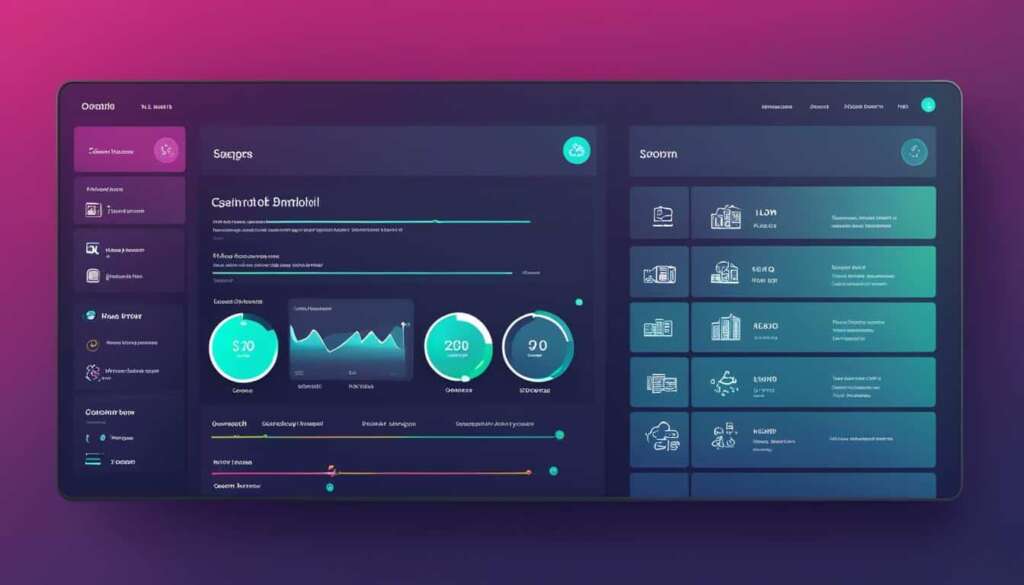Table of Contents
In the world of e-learning practices, a learning management system (LMS) plays a vital role in revolutionizing the way we educate and train. By harnessing the power of technology, an LMS brings together instructors, students, and administrators in a seamless online learning environment.
Gone are the days of solely relying on traditional educational methods. With an LMS, instructors can create and deliver engaging content, monitor student participation, and assess performance in real-time. Students, on the other hand, can access a variety of interactive features like discussions, video conferencing, and forums, enhancing their learning experience.
But what makes an LMS truly remarkable is its ability to save time and money. Whether it’s a business, government agency, or educational institution, utilizing an LMS streamlines educational processes and eliminates the need for physical resources and travel expenses.
One important aspect of LMSes is their adherence to the Sharable Content Object Reference Model (SCORM), which promotes standardization. This means that popular LMSes like Moodle, Blackboard Learn, and Schoology Learning are designed to support interoperability, allowing seamless sharing of learning content among different platforms.
In the following sections, we will explore the benefits of using an LMS, its various applications, how it works, the different deployment options available, and the payment models associated with LMSes. Additionally, we will delve into the importance of SCORM and highlight the wide range of users who can benefit from implementing an LMS.
Benefits of Using an LMS
When it comes to effective training and learning management, an LMS (Learning Management System) offers numerous benefits that can revolutionize the way organizations educate and upskill their workforce. In this section, we will explore the key advantages of using an LMS, ranging from time and cost-saving features to personalized learning experiences.
Time and Cost-saving
One of the most significant benefits of an LMS is its ability to save time and reduce costs for organizations. With an LMS, learners can complete their training at their convenience, eliminating the need for travel or in-person instructors. This flexibility enables employees to learn at their own pace, leading to increased efficiency and productivity.
Monitoring Learning Progress
An LMS allows organizations to track and monitor the progress of their learners. Through built-in analytics and reporting features, administrators can gain valuable insights into the learning journey of each individual. This feature enables targeted interventions and personalized support to enhance the learning experience and maximize knowledge retention.
Scalable and Personalized Learning
Whether your organization has a few employees or thousands, an LMS provides a scalable solution to accommodate any number of learners. It offers personalized learning paths tailored to each individual’s needs, enabling learners to focus on areas where they need improvement and skip content they already know. This personalized approach boosts engagement and promotes effective learning outcomes.
Efficient Training Management
An LMS offers centralized training management, allowing organizations to store, organize, and distribute training materials from a single platform. This eliminates the need for physical copies or multiple systems, streamlining the training process and ensuring consistency across the organization.
Tracking and Reporting
With an LMS, tracking learner performance and progress becomes seamless. The system provides comprehensive reports and analytics, giving administrators and trainers real-time data on learner engagement, completion rates, and assessment scores. These insights enable organizations to make data-driven decisions and continually improve their training programs.
Assessment and Certification
Assessment and certification are crucial aspects of training and learning. An LMS facilitates the creation and delivery of assessments, allowing organizations to evaluate the knowledge and skills acquired by learners. Additionally, it enables the issuance of certificates upon successful completion of training programs, enhancing recognition and motivating learners to continue their professional development.
By harnessing the power of an LMS, organizations can unlock a host of benefits that enhance training efficiency, empower learners, and drive growth. The next section will explore the various applications of learning management systems in different contexts.
Applications of Learning Management Systems
Learning management systems (LMS) have become vital tools for a wide range of applications. Organizations across industries utilize LMS applications to streamline various training processes, enhance learning experiences, and achieve their training goals. Let’s explore some of the key applications of LMS:
1. Employee Training
One of the primary uses of LMS is for employee training. Whether it’s onboarding new hires, conducting compliance training, or providing ongoing skill development, LMS applications offer a centralized platform for organizations to deliver efficient and effective training to their workforce.
2. Sales Training
LMSes are also widely employed for sales training. This application enables sales teams to enhance their product knowledge, learn effective sales techniques, and stay updated with the latest sales strategies. With LMS, sales professionals can access training materials anytime, anywhere, and track their progress to continually improve their performance.
3. Customer Training
Providing training to customers is another valuable application of LMS. Organizations can deliver product-specific training, tutorials, and guides to enhance customers’ understanding and usage of their offerings. LMS applications allow companies to build strong relationships with customers by providing valuable educational resources.
4. Partner Training
LMSes are also utilized for partner training, enabling organizations to educate their channel partners, distributors, and resellers about their products or services. This application ensures that partners have the necessary knowledge and skills to effectively promote, sell, and support the organization’s offerings.
5. Blended Learning
Blended learning, which combines traditional classroom teaching with online learning tools, is made possible through LMS applications. Organizations can create a blended learning environment where learners can access various digital resources, collaborate with peers, and engage in interactive learning activities to optimize their learning outcomes.
In corporate settings, LMSes are widely used to streamline employee training, including onboarding, compliance training, and sales training. They are also employed for training customers and partners, aiming to enhance product knowledge and build valuable relationships. Additionally, LMSes facilitate blended learning, which combines online resources and traditional teaching methods to provide a comprehensive learning experience
How Learning Management Systems Work
LMSes (Learning Management Systems) offer a wide range of functionality to facilitate effective online learning experiences. Let’s explore some key features:
Responsive Design
LMSes are designed with responsive layouts, enabling seamless access from any device, whether it’s a desktop computer, tablet, or smartphone. This flexibility ensures learners can engage with the platform anytime, anywhere, making learning accessible and convenient.
User-Friendly Interface
An intuitive and user-friendly interface is crucial for optimal learning experiences. LMSes prioritize navigation ease, providing learners with a straightforward interface that enhances their overall user experience. This ensures learners can easily locate and access the training materials they need.
Reports and Analytics
LMSes offer robust reporting and analytics functionalities. These features provide valuable insights into learner progress, participation, and performance. Educators and administrators can track learner engagement, identify areas of improvement, and make data-driven decisions to enhance the effectiveness of training programs.
Course Management
Course management capabilities within LMSes enable instructors to create, organize, and deliver course content efficiently. Instructors can create content, set up assessments, and schedule learning activities, streamlining the overall learning experience. Learners benefit from a structured and organized approach to their coursework.
Content Interoperability and Integration
LMSes prioritize content interoperability and integration with industry standards such as SCORM (Sharable Content Object Reference Model). This ensures that learning materials created in different formats can be seamlessly imported and integrated into the LMS, providing a diverse and engaging learning experience for learners.
Support Services
Comprehensive support services are available within LMSes to assist learners, instructors, and administrators. Help desks, online documentation, and user forums provide a valuable resource for troubleshooting and resolving any issues that may arise during the learning process.
Certification and Compliance Support
LMSes offer certification and compliance support, enabling organizations to track and manage certifications for learners. These platforms ensure compliance with regulatory requirements and industry standards, providing learners with recognized credentials upon successful completion of courses.
Social Learning Capabilities
Social learning capabilities within LMSes foster collaboration and interaction among learners, enabling them to engage in discussions, forums, and online communities. This facilitates knowledge sharing, peer-to-peer learning, and a sense of community, enhancing the overall learning experience.
Gamification
Gamification elements are integrated into LMSes to enhance learner engagement and motivation. These features include badges, leaderboards, and rewards, creating a gamified learning environment that encourages healthy competition and achievement.
Automation
LMSes streamline administrative tasks through automation, reducing manual efforts. Automated features include learner enrollment, course progress tracking, assessment grading, and certificate generation. This frees up instructors and administrators to focus on delivering quality content and supporting learner success.
Localization
LMSes support localization, allowing the platform to be translated and adapted to different languages and cultural contexts. This feature ensures that learners worldwide can access and engage with course materials in a language that is familiar and comfortable to them.
Artificial Intelligence
Artificial Intelligence is increasingly being integrated into LMSes, enhancing the learning experience through personalized recommendations, adaptive learning paths, and intelligent feedback. AI algorithms analyze learner data to provide tailored content and learning experiences based on individual needs and preferences.
| Functionality | Description |
|---|---|
| Responsive Design | LMSes have responsive layouts, enabling access from any device. |
| User-Friendly Interface | LMSes prioritize intuitive and easy-to-use interfaces for seamless navigation. |
| Reports and Analytics | LMSes offer robust reporting and analytics to track learner progress and performance. |
| Course Management | Instructors can efficiently create, organize, and deliver course content. |
| Content Interoperability and Integration | LMSes ensure compatibility and seamless integration of diverse learning materials. |
| Support Services | LMSes provide comprehensive support resources for learners and administrators. |
| Certification and Compliance Support | LMSes enable tracking and management of certifications and compliance requirements. |
| Social Learning Capabilities | LMSes foster collaboration and community through discussions and online forums. |
| Gamification | Interactive elements like badges and leaderboards enhance learner engagement. |
| Automation | LMSes automate administrative tasks, saving time and effort for instructors. |
| Localization | LMSes support translations and cultural adaptation for global accessibility. |
| Artificial Intelligence | AI algorithms personalize learning experiences and provide intelligent feedback. |
Types of LMS Deployments
When it comes to learning management system (LMS) deployments, there are several options available to suit different organizational needs. Each deployment option has its advantages and considerations, so understanding the differences is crucial in making the right choice for your organization.
Cloud-based LMS
Cloud-based LMSes are hosted on the cloud and accessed through a web browser. This deployment option offers flexibility and ease of access since users can log in from any device with an internet connection. Cloud-based LMSes eliminate the need for organizations to manage server infrastructure and provide automatic updates and maintenance. They are ideal for organizations with remote teams or those looking for a scalable solution.
Self-hosted LMS
Self-hosted LMSes require installation and maintenance by the organization itself. This option allows for customization and control over the LMS’s features and functionality. However, it also entails the responsibility of managing server infrastructure, backups, and security. Self-hosted LMSes are suitable for organizations with specialized IT resources or specific security requirements.
Third-party Hosted LMS
Third-party hosted LMSes are hosted by external organizations and accessed online. With this deployment option, organizations don’t need to manage or maintain server infrastructure. They can benefit from the expertise and support of the hosting provider. Third-party hosted LMSes are convenient for organizations that prioritize ease of use, quick deployment, and ongoing technical support.
Desktop Application LMS
Desktop application LMSes are installed locally on a user’s computer. This deployment option allows for offline access to training content and data. Desktop application LMSes may be suitable for organizations with limited or unreliable internet connectivity or those that prefer to have complete control over their LMS environment.
Mobile Application LMS
Mobile application LMSes enable learners to access learning content and participate in training activities on smartphones and tablets. This deployment option allows for learning on the go and supports the growing trend of mobile learning. Mobile application LMSes are ideal for organizations with a mobile workforce or learners who prefer accessing training materials through their mobile devices.
Choosing the right LMS deployment is essential to ensure optimal user experience, scalability, and management. Consider the specific needs and resources of your organization to determine which option aligns best with your goals.
| Deployment Option | Advantages | Considerations |
|---|---|---|
| Cloud-based LMS | Flexible access, automatic updates, scalability | Dependent on internet connectivity |
| Self-hosted LMS | Customization, control, specialized security | Requires server management and maintenance |
| Third-party Hosted LMS | Convenience, technical support, quick deployment | Reliance on external hosting provider |
| Desktop Application LMS | Offline access, complete control | Limited to specific devices, updates may be manual |
| Mobile Application LMS | Mobile learning, on-the-go access | Might have limitations in terms of functionality |
In today’s digital world, organizations have various deployment options for their learning management systems. Whether you opt for a cloud-based, self-hosted, third-party hosted, desktop application, or mobile application LMS, understanding the unique advantages and considerations of each deployment option is crucial. Let’s explore the different types of LMS deployments and help you find the right fit for your organization.
Payment Options for LMSes
LMSes offer various pricing models to meet the diverse needs of organizations. Understanding these pricing models is crucial when selecting the right learning management system for your business. Let’s explore the different payment options available:
1. Freemium Model
The freemium model is a popular choice for businesses looking to get started with an LMS. It offers basic features for free, allowing organizations to test and experience the benefits of an LMS without any upfront cost. However, advanced functionalities often require a paid upgrade.
2. Subscription Model
The subscription model involves regular payments for continued access to the LMS. Subscriptions can be billed monthly, quarterly, or annually, depending on the provider. This model provides organizations with ongoing support, updates, and access to new features as they are released.
3. Licensing
Licensing is another payment option for LMSes. It typically involves either annual renewal fees or a one-time lifetime access fee. Licensing provides organizations with long-term access to the LMS and may include additional benefits like priority support or customization options.
4. Open Source
Open source LMSes are available at no cost and are a popular choice for organizations with limited budgets or those seeking more flexibility. Open source LMSes allow businesses to customize and modify the software according to their specific needs. Examples of open source LMSes include Chamilo, EdApp, Ilias, Moodle, and Sakai.
By understanding the different pricing models available, organizations can make informed decisions when selecting an LMS that aligns with their budget and requirements.
Stay tuned for the upcoming sections as we delve into the importance of SCORM in an LMS and explore the diverse range of organizations and individuals who benefit from using an LMS.
What is SCORM and its Importance in LMS
SCORM, which stands for Sharable Content Object Reference Model, is a set of standards that provides a framework for structuring and exchanging learning content. It enables the creation of learning objects that can be easily shared across different platforms without the need for modification. This ensures seamless compatibility and ease of use when importing third-party courses into an LMS.
“SCORM allows for the packaging of content into reusable, self-contained modules known as Sharable Content Objects (SCOs). These SCOs can consist of text, images, videos, assessments, and other multimedia elements, providing a comprehensive learning experience.”
With SCORM, instructional designers and content developers can package content into standardized modules, making it easy to store, manage, and deliver within an LMS. SCORM-compliant content ensures that all the necessary components, such as assessments, progress tracking, and run-time communication, are supported.
The run-time communication aspect of SCORM allows for dynamic interaction between the learner and the content. It enables tracking and recording of learner progress, completion status, and performance data, which can then be leveraged for reporting purposes.
SCORM compatibility is essential for LMSes as it allows organizations to import third-party courses from various sources without compatibility issues. This opens up opportunities for organizations to expand their training options and provide learners with a wide range of educational resources.
Benefits of SCORM in LMS:
- Facilitates seamless import and integration of third-party courses
- Ensures standardization and compatibility of learning content
- Enables tracking and reporting of learner progress
- Supports interactive and engaging learning experiences
- Promotes efficient management of learning resources
Overall, SCORM plays a vital role in the effectiveness and efficiency of an LMS by providing a standardized framework for packaging and delivering learning content. It enables organizations to leverage a wide range of educational resources, enhance the learning experience, and ensure compatibility with different platforms.
| SCORM Features | Benefits |
|---|---|
| Packaging content into reusable modules | Simplifies storage and management of learning content |
| Run-time communication and tracking | Enables real-time assessment and progress tracking |
| Compatibility with third-party courses | Expands training options and resources |
Who Needs and Uses an LMS
LMSes are widely used by organizations across various industries, catering to the needs of both small to medium enterprises (SMEs) and large enterprises. SMEs benefit from LMSes as they provide an affordable solution for delivering effective training and education to their workforce. LMSes offer a centralized platform for managing and delivering training materials efficiently, saving time and resources for these businesses.
In addition to SMEs, LMSes also play a crucial role in meeting the training needs of large enterprises. With a large number of employees, these organizations require a scalable and robust system that can handle the volume and complexity of their training programs. LMSes provide the necessary tools and features to support the training and development initiatives of large enterprises, ensuring that employees receive the knowledge and skills they need to succeed.
Furthermore, LMSes are embraced by industries that require specialized product training. Software companies, for example, leverage LMSes to deliver comprehensive training to their customers on the usage and features of their products. By using an LMS, these companies can create interactive courses, monitor learners’ progress, and provide ongoing support, resulting in improved customer satisfaction and product adoption.
Finally, educators also find value in using LMSes for delivering online education. Whether in traditional educational institutions or corporate training environments, LMSes offer a flexible and user-friendly platform for educators to create, manage, and deliver engaging learning content. LMSes enable educators to personalize the learning experience, track student progress, and provide timely feedback, enhancing the overall educational journey for both students and teachers.
FAQ
What is a learning management system (LMS)?
A learning management system (LMS) is a software application or web-based technology that facilitates e-learning practices. It consists of a server that performs the base functionality and a user interface (UI) operated by instructors, students, and administrators.
What are the benefits of using an LMS?
An LMS saves organizations time and money by allowing learners to complete training at their own pace and location without the need for instructors or travel. It enables monitoring of learning progress and performance, making training more efficient. LMSes are scalable, accommodating a large number of learners, and support personalized learning paths. They also enable centralization of training materials, tracking and reporting of learner performance, and offer assessments and certifications for skill development and recognition.
What are the applications of learning management systems?
LMSes are used for various applications, including employee training such as onboarding, compliance training, and sales training. They are also used for customer and partner training, delivering education on products and building valuable relationships. Additionally, LMSes facilitate blended learning, combining traditional classroom teaching with online learning tools for a more effective learning experience.
How do learning management systems work?
LMSes have responsive designs that allow access from any device and provide downloadable content. They have user-friendly interfaces to improve navigation and user experience. Reports and analytics offer insights into training effectiveness. LMSes support course and content management, ensuring targeted learning experiences. They promote content interoperability and integration with standards like SCORM. Support services and certification compliance support are available. Social learning capabilities, gamification, automation, localization, and artificial intelligence enhance the learning experience.
What are the types of LMS deployments?
LMSes can be cloud-based, hosted on the cloud and accessible through a web browser for flexibility and ease of access. They can also be self-hosted, requiring installation and maintenance by the organization for customization but with additional maintenance responsibilities. Third-party hosted LMSes are hosted by external organizations and accessed online. Desktop application LMSes are installed locally on a user’s computer, and mobile application LMSes support mobile learning on smartphones and tablets.
What are the payment options for LMSes?
LMSes offer various pricing models. Freemium models provide basic features for free and charge for advanced functionalities. Subscription models require regular payments for access to the LMS. Licensing involves either annual renewal fees or one-time lifetime access fees. Open source LMSes are available at no cost.
What is SCORM and why is it important in LMS?
SCORM stands for Sharable Content Object Reference Model. It is a set of standards for structuring and exchanging learning content, allowing the creation of learning objects that can be shared across different platforms without modification. SCORM-compliant content ensures compatibility and ease of use when importing third-party courses into an LMS.
Who needs and uses an LMS?
LMSes are used by various organizations, including small to medium enterprises and large enterprises. They are also used for specialized product training, such as software companies training their customers. Educators also benefit from using LMSes to deliver online education. LMSes provide a centralized platform for managing and delivering training materials efficiently.








